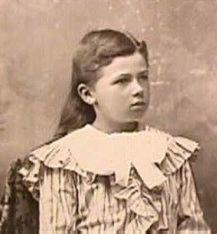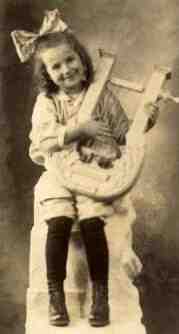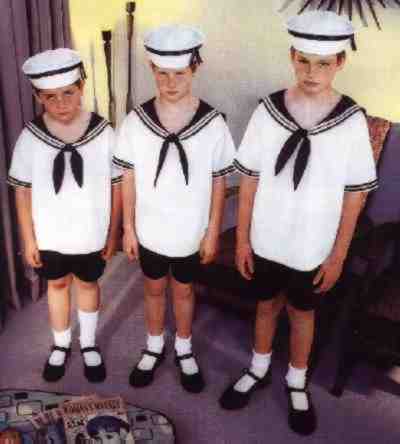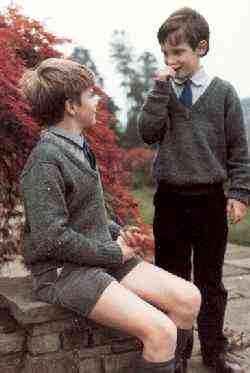
Boys' Clothes: Image and Fashion
 Figure 1.--This boy in Fargo, North Dakota wore dresses until he was about 10 or 11 years old. After he was breeched, his mother had him put one of his dresses back on for a photograph. Obviously the image his clothes projected was what his mother wanted, not what he desired. Click on the photograph for details about this boy.
Figure 1.--This boy in Fargo, North Dakota wore dresses until he was about 10 or 11 years old. After he was breeched, his mother had him put one of his dresses back on for a photograph. Obviously the image his clothes projected was what his mother wanted, not what he desired. Click on the photograph for details about this boy.
|
Clothes send all kinds of obvious and some more subtle signials. This has been the case since time immerorial. Many scocities have had actual laws detailing whio could wear what. The Roman emperors reserved the color purple for themselves. During the middle ages sumptory laws precented rich merchants from putting on aristocratoc airs and dressing like the nobles. The primary purpose of fashion was to demonstrate one's social rank. Children's fashions were until recently a simply reflection of this fact. This has changed significantly in the late 20th Century as children have increasingly insisted on selecting their own clothes--and younger and younger children are making their choices known. The priorities of the modern child can be quite different than those of their parents.
Adult Fashion
In our modern age it has been a question of money as who can wear what. Fashion have traditionally been set by the wealthy and then copied by the aspiring masses. Often the wealthier class used clothes to separate them selves from the great unwashed masses. In some ages this meant very formal elaborate clothes. Some newly wealthy individuals, however, at first had trouble getting style quite right. They had money to afford what they wanted,but often had trouble getting the styles quite right. Fashion was for many a way of keeping a step ahead of the cheaper copies of fashionable dress made for mass sales.
Traditional Children's Fashions: Adult Priorities
Childrens fashions for as long as children have worn clothes followed the same basic princile. They were dresses by theirparents to demonstrate the familys social position. Until the late 19th Century this meant small scaled down versions of their parents clothes. Little boys before breeching wore the dress styles of their mothers. After their breeching they wore the styles of their fathers. Fpr the nobility this usually been elaborate styles and sumptuous fabrics to demonstrate their status. Wealthy merchants dressed as finely as the laws allowed. Some exceptions existed such as the puritans who as a matter of religuin dressed as plainly as possible.
The development of specialized children's fashions in the late 18th Century changed little. Parents continued to dress their children to reflect the family's social status. Only now there were specialized children's clothes. In some eras the new children's clothes seemed to reflect the needs of the child, such as the comfortable open collars of the late 18th Century and early 19th Century. Other eras such as the late 19th Century required tight coolars such as the large lace collars and bows worn with Little Lord Fauntleroy suits. Such an outfit made no concessiion to childhood, but was rather a reflection of how mothers wished their children to appear as a reflection of their romantic notions of childhood and to demonstrate the social staus of the family
 Figure 2.--This is another image of a boy whose mother had a very definite idea of the image that she wanted for her boy. You might think that this 1915 photograph was a girl, but girls at the time did not wear knickers. Some little boys stll wore dresses and curls, although the hairbow--especially in Amweica was a rarity.
Figure 2.--This is another image of a boy whose mother had a very definite idea of the image that she wanted for her boy. You might think that this 1915 photograph was a girl, but girls at the time did not wear knickers. Some little boys stll wore dresses and curls, although the hairbow--especially in Amweica was a rarity.
|
Children's fashions in the 20th Century gradually developed styles more intune to the needs of childre. Comfortable open neck shirts and styles such as short pants and rompers and the jeans, "t"shirts, and sweat shirts of the modern child. Even so, for most of the first half of the Century, a child's clothes still reflected the tastes and pretensions of the parents. Many mothers insisted their sons wear smart looking short pants or wear their knickers above the knee. With the rise of public education, however, mothers generally had less leeway than in the past wher a boy or girl was raised more at home and had fewer contacts with other children outside of the family. Even so, children's styles were still set by the wealthy or by movie actors--a new development of the 20th Century.
The Image of Short Pants
Although short pants in the Statesbecame something that mothers wanted boys to wear, while boys themselveswanted longs, I don't think it was that way in some other countries. It appears to have been different in England, Australia, New Zealand and some other countries. Boys in any country have always wanted to dress like men--and not just any kind of man, but "culture heroes", as it were. In theU.S., that meant cowboys--thus the popularity of jeans, cowboy hats etc. But in Britain, I think that was colonial adventurers. I've travelled inmany of the former British colonies in the tropics, and if I'm notmistaken, short pants and knee socks were first worn not by boys but byBritish soldiers and "scouts" as a way of coping with the heat. Plantersin the Malay states, soldiers in South Africa (Boer War), Australianssettling the outback--short trousers and knee socks were what the menwore (and still do in rural Australia, South Africa, New Zealand; I oncevisited the government offices in Darwin; most of the men were wearing thevery short Australian "stubbies", long white knee socks, short sleevedshirts and neckties.) My guess (although it needs to be backed up byhistorical research) is that Baden-Powell adopted this "scout" uniform for"boy scouts" to dress them up like real military, adventure scouts. Theinteresting question, then, is why and how short pants gradually came to bethought of as somewhat prissy, Mother's boy clothes. Jeans also becameboys' clothes, but never got that image.
Certainly many mothers think that boys look attractive in short pants, particulary when worn short andwith knee socks. Perhaps because this emphasizes a boys' imaturity and many mothers want to keep their boys from growing up to soon and loosing them to the adult world, But of course this is just what most boys want any why so often they object to wearing dressy short pants.
Modern Children's Fashions: Children's Priorities
A radical new development has occurred in the late 20th Century. It is a reflection of the increasing independence of the modern child. Children, even quite young children, now have great say in what they wear. Older teenagers in America often have part time jobs and purchase many of theirvown clothes. Younger children still relying on their parents, howevers, now largely insist on selecting their own clothes. Girls are still more concerned about clothes than boys, but even boys that re not clothes concious generally have very definite ideas about what they will and will not wear.
 Figure 3.--This photograph was taken by a photographer trying to picture confority. Interesting the boys would actually stand out as rugged individualists. Their friends all wear "T" shirts, jeans, and sneakers.
Figure 3.--This photograph was taken by a photographer trying to picture confority. Interesting the boys would actually stand out as rugged individualists. Their friends all wear "T" shirts, jeans, and sneakers.
|
With the new authority of the child has come many new trends in children's clothes. Some of the trends are continuations of already developing trends like the shift to casual clothing. Other trends are very new, such as a new development such as looking to low-income groups for fashions trends rayher than following the styles of the wealthy.
Conformity: The major concern of the modern boy is conformity. He does not want to stand out from his peers. He wants to fit in. Mothers at the turn of the Century could insist on Little Lord Fauntleroy suits or long curls because the boy was raised at home. Boys in the 1940s and 50s whose mothers insisted on short pants while the other moys werre wearing knickers or jeans, had to endure the taunts of their school mates. More recently it has been xcertain brands of sneakers or jeans. Until recently it was mother who made these decisions. Children's ideas on fashion were generally dismissed. But now parents give great attention to what their son wants. And what he wants is conformity.
Cool: Children also want what they preceive as cool. This is a modern phenomenon. Such ideas often come from adertising. But the best advertising often picks up on on going feelings and trends and does not occur in isolation. Since the development of motion pictures, fashions appearing in the movies or worn by revered sports stars are seized upon by children--or also adults. Interestingly this would not have beeb the case before our modern era. Actor and actresses were looked down on by Victorian Europe and parents would not even considered dressing their child like entrtainers. At the time entertainers followed the fashion trends of the rich. This imperitive for the infashion caused children and teenagers to seek garments such as $100 sneakers when their parents can barely make the rent payments.

Figure 4.--Usually the younger boys at a British school wore short pants and kneesocks. The older boys saw long pants as giving them an older , more mature look. Some parents, however, insisted that their sons wear short pants even as older students. For the boys this was often a symbol of a lack of independence.
|
Indpendence: Modern children use clothes a a way of demonstrating their independence from their parents. A boy wearing a kilt or Fauntleroy suit or in our modern era, a short pants suit--obviouly had his clothes chosen by his mother. Boys wearing long pants, no matter how ragged demonstrated that he was growing up and establishing his identity as a young man. For many boys, long trousers were a reason to look down on their still juvenile-outfitted pears. For the modern boy, sweat shirts and jeans--and recently baggy jeans was a sign that he and not his mother was obviously choosing his own clothes.
Casual/comfortable: One key to children is comfort. Thus casual styles such as open collars and short pants are well suited to the active, growing child. Other fashions such as coveralls and shortalls are well suited sor little children. Older American children took to Keds and jeans in the late 1940s. European boys wore shorts and sandals until the Americanization of children's fashions began in the 1950s.
Lower class: One of the interesting developments in the 1990s is that young people turned to lower-income Black Americans for fashion trends. Thus hip-hop fashions of over-sized "T" shirts and baggy jeans have become fashion stables.
HBC

Navigate the Historic Boys' Clothing Web Site:
[Return to the Main essay page]
[Introduction]
[Activities]
[Biographies]
[Chronology]
[Cloth and textiles]
[Clothing styles]
[Countries]
[Topics]
[Bibliographies]
[Contributions]
[FAQs]
[Glossaries]
[Images]
[Satellite sites]
[Tools]
[Boys' Clothing Home]
Navigate the Historic Boys' Clothing Web style pa ges:
[Short pants suits]
[Blazers]
[Lace collars]
[Fauntleroy suits]
[Sailor suits]
[Ring bearer/page costumes]
[First Communion suits]
Created: November 3, 1998
Last updated: July 20, 1999
 Figure 1.--This boy in Fargo, North Dakota wore dresses until he was about 10 or 11 years old. After he was breeched, his mother had him put one of his dresses back on for a photograph. Obviously the image his clothes projected was what his mother wanted, not what he desired. Click on the photograph for details about this boy.
Figure 1.--This boy in Fargo, North Dakota wore dresses until he was about 10 or 11 years old. After he was breeched, his mother had him put one of his dresses back on for a photograph. Obviously the image his clothes projected was what his mother wanted, not what he desired. Click on the photograph for details about this boy.




